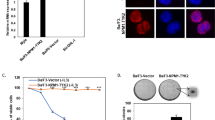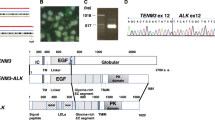Abstract
The congenital fibrosarcoma t(12;15)(p13;q25) rearrangement splices the ETV6 (TEL) gene on chromosome 12p13 in frame with the NTRK3 (TRKC) neurotrophin-3 receptor gene on chromosome 15q25. Resultant ETV6-NTRK3 fusion transcripts encode the helix–loop–helix (HLH) dimerization domain of ETV6 fused to the protein tyrosine kinase (PTK) domain of NTRK3. We show here that ETV6-NTRK3 homodimerizes and is capable of forming heterodimers with wild-type ETV6. Moreover, ETV6-NTRK3 has PTK activity and is autophosphorylated on tyrosine residues. To determine if the fusion protein has transforming activity, NIH3T3 cells were infected with recombinant retroviral vectors carrying the full-length ETV6-NTRK3 cDNA. These cells exhibited a transformed phenotype, grew macroscopic colonies in soft agar, and formed tumors in severe combined immunodeficient (SCID) mice. We hypothesize that chimeric proteins mediate transformation by dysregulating NTRK3 signal transduction pathways via ligand-independent dimerization and PTK activation. To test this hypothesis, we expressed a series of ETV6-NTRK3 mutants in NIH3T3 cells and assessed their transformation activities. Deletion of the ETV6 HLH domain abolished dimer formation with either ETV6 or ETV6-NTRK3, and cells expressing this mutant protein were morphologically non-transformed and failed to grow in soft agar. An ATP-binding mutant failed to autophosphorylate and completely lacked transformation activity. Mutants of the three NTRK3 PTK activation-loop tyrosines had variable PTK activity but had limited to absent transformation activity. Of a series of signaling molecules well known to bind to wild-type NTRK3, only phospholipase-Cγ (PLCγ) associated with ETV6-NTRK3. However, a PTK active mutant unable to bind PLCγ did not show defects in transformation activity. Our studies confirm that ETV6-NTRK3 is a transforming protein that requires both an intact dimerization domain and a functional PTK domain for transformation activity.
This is a preview of subscription content, access via your institution
Access options
Subscribe to this journal
Receive 50 print issues and online access
$259.00 per year
only $5.18 per issue
Buy this article
- Purchase on Springer Link
- Instant access to full article PDF
Prices may be subject to local taxes which are calculated during checkout






Similar content being viewed by others
References
Adam LR, Davison EV, Malcolm AJ, Pearson ADJ and Craft AW. . 1990 Cancer Genet. Cytogenet. 48: 193–198.
Argyle JC, Tomlinson GE, Stewart D and Schneider NR. . 1992 Arch. Pathol. Lab. Med. 116: 972–975.
Baens M, Peeters P, Guo C, Aerssens J and Marynen P. . 1996 Genome Res. 6: 404–413.
Barbacid M. . 1994 J. Neurobiol. 25: 1386–1403.
Barbacid M. . 1995a Curr. Opin. Cell Biol. 7: 148–155.
Barbacid M. . 1995b Ann. NY Acad. Sci. 766: 442–458.
Berridge MJ . 1993 Nature 361: 315–325.
Bilderback TR, Gazula VR, Lisanti MP and Dobrowsky RT. . 1999 J. Biol. Chem. 274: 257–263.
Bonfini L, Migliaccio E, Pelicci G, Lanfrancone L and Pelicci PG. . 1996 Trends Biochem. Sci. 21: 257–261.
Buijs A, Sherr S, van Baal S, van Bezouw S, van der Plas D, Geurts van Kessel A, Riegman P, Lekanne Deprez R, Zwarthoff E and Hagemeijer A, et al. 1995 Oncogene 10: 1511–1519.
Carroll M, Tomasson MH, Barker GF, Golub TR and Gilliland DG. . 1996 Proc. Natl. Acad. Sci. USA 93: 14845–14850.
Cave H, Cacheux V, Raynaud S, Brunie G, Bakkus M, Cochaux P, Preudhomme C, Lai JL, Vilmer E and Grandchamp B. . 1997 Leukemia 11: 1459–1464.
Chase A, Reiter A, Burci L, Cazzaniga G, Biondi A, Pickard J, Roberts IA, Goldman JM and Cross NC. . 1999 Blood 93: 1025–1031.
Cockcroft S and Thomas GM. . 1992 Biochem. J. 288: 1–14.
Coffin CM, Jaszcz W, O'Shea P and Dehner LP. . 1994 Pediatric Pathology 14: 133–150.
Conover JC and Yancopoulos GD. . 1997 Rev. Neurosci. 8: 13–27.
Cools J, Bilhou-Nabera C, Wlodarska I, Cabrol C, Talmant P, Bernard P, Hagemeijer A and Marynen P. . 1999 Blood 94: 1820–1824.
Cunningham ME, Stephens RM, Kaplan DR and Greene LA. . 1997 J. Biol. Chem. 272: 10957–10967.
Downward J. . 1996 Cancer Surv. 27: 87–100.
Ebadi M, Bashir RM, Heidrick ML, Hamada FM, Refaey HE, Hamed A, Helal G, Baxi MD, Cerutis DR and Lassi NK. . 1997 Neurochem. Int. 30: 347–374.
Edel MJ. . 1998 Anticancer Res. 18: 4505–4509.
Eguchi M, Eguchi-Ishimae M, Tojo A, Morishita K, Suzuki K, Sato Y, Kudoh S, Tanaka K, Setoyama M, Nagamura F, Asano S and Kamada N. . 1999 Blood 93: 1355–1363.
Golub TR, Barker GF, Bohlander SK, Hiebert SW, Ward DC, Bray-Ward P, Morgan E, Raimondi SC, Rowley JD and Gilliland DG. . 1995 Proc. Natl. Acad. Sci. USA 92: 4917–4921.
Golub TR, Barker GF, Lovett M and Gilliland DG. . 1994 Cell 77: 307–316.
Golub TR, Goga A, Barker GF, Afar DE, McLaughlin J, Bohlander SK, Rowley JD, Witte ON and Gilliland DG. . 1996 Mol. Cell. Biol. 16: 4107–4116.
Guiton M, Gunn-Moore FJ, Glass DJ, Geis DR, Yancopoulos GD and Tavare JM. . 1995 J. Biol. Chem. 270: 20384–20390.
Gunn-Moore FJ, Williams AG and Tavare JM. . 1997 Biochem. J. 322: 193–198.
Hallberg B, Ashcroft M, Loeb DM, Kaplan DR and Downward J. . 1998 Oncogene 17: 691–697.
Hawley RG, Lieu FH, Fong AZ and Hawley TS. . 1994 Gene Ther. 1: 136–138.
Ho JM, Beattie BK, Squire JA, Frank DA and Barber DL. . 1999 Blood 93: 4354–4364.
Holgado-Madruga M, Moscatello DK, Emlet DR, Dieterich R and Wong AJ. . 1997 Proc. Natl. Acad. Sci. USA 94: 12419–12424.
Ichaso N, Rodriguez RE, Martin-Zanca D and Gonzalez-Sarmiento R. . 1998 Oncogene 17: 1871–1875.
Janssen JW, Ridge SA, Papadopoulos P, Cotter F, Ludwig WD, Fonatsch C, Rieder H, Ostertag W, Bartram CR and Wiedemann LM. . 1995 Br. J. Haematol. 90: 222–224.
Jing S, Tapley P and Barbacid M. . 1992 Neuron 9: 1067–1079.
Kaplan DR. . 1997 Curr. Opin. Cell Biol. 9: 213–221.
Knezevich SR, Garnett MJ, Pysher TJ, Beckwith JB, Grundy PE and Sorensen PH. . 1998a Cancer Res. 58: 5046–5048.
Knezevich SR, McFadden DE, Tao W, Lim JF and Sorensen PH. . 1998b Nat. Genet. 18: 184–187.
Kouhara H, Hadari YR, Spivak-Kroizman T, Schilling J, Bar-Sagi D, Lax I and Schlessinger J. . 1997 Cell 89: 693–702.
Kwiatkowski BA, Bastian LS, Bauer Jr TR, Tsai S, Zielinska-Kwiatkowska AG and Hickstein DD. . 1998 J. Biol. Chem. 273: 17525–17530.
Lacronique V, Boureux A, Valle VD, Poirel H, Quang CT, Mauchauffe M, Berthou C, Lessard M, Berger R, Ghysdael J and Bernard OA. . 1997 Science 278: 1309–1312.
Lamballe F, Klein R and Barbacid M. . 1991 Cell 66: 967–979.
Lamballe F, Tapley P and Barbacid M. . 1993 EMBO J. 12: 3083–3094.
Lee SB and Rhee SG. . 1995 Curr. Opin. Cell Biol. 7: 183–189.
Lemmon MA and Schlessinger J. . 1994 Trends Biochem. Sci. 19: 459–463.
Mandahl S, Heim S, Rydholm A, Willen H and Mitelman F. . 1989 Cancer Genet. Cytogenet. 40: 137–139.
May WA, Lessnick SL, Braun BS, Klemsz M, Lewis BC, Lunsford LB, Hromas R and Denny CT. . 1993 Mol. Cell. Biol. 13: 7393–7398.
McGregor LM, Baylin SB, Griffin CA, Hawkins AL and Nelkin BD. . 1994 Genomics 22: 267–272.
Mitra G. . 1991 Oncogene 6: 2237–2241.
Nishizuka Y. . 1995 FASEB J. 9: 484–496.
O'Connor HE, Butler TA, Clark R, Swanton S, Harrison CJ, Secker-Walker LM and Foroni L. . 1998 Leukemia 12: 1099–1061.
Obermeier A, Halfter H, Wiesmuller KH, Jung G, Schlessinger J and Ullrich A. . 1993a EMBO J. 12: 933–941.
Obermeier A, Lammers R, Wiesmuller KH, Jung G, Schlessinger J and Ullrich A. . 1993b J. Biol. Chem. 268: 22963–22966.
Ong SH, Goh KC, Lim YP, Low BC, Klint P, Claesson-Welsh L, Cao X, Tan YH and Guy GR. . 1996 Biochem. Biophys. Res. Commun. 225: 1021–1026.
Papadopoulos P, Ridge SA, Boucher CA, Stocking C and Wiedemann LM. . 1995 Cancer Res. 55: 34–38.
Pear WS, Nolan GP, Scott ML and Baltimore D. . 1993 Proc. Natl. Acad. Sci. USA 90: 8392–8396.
Peeters P, Raynaud SD, Cools J, Wlodarska I, Grosgeorge J, Philip P, Monpoux F, Van Rompaey L, Baens M, Van den Berghe H and Marynen P. . 1997a Blood 90: 2535–2540.
Peeters P, Wlodarska I, Baens M, Criel A, Selleslag D, Hagemeijer A, Van den Berghe H and Marynen P. . 1997b Cancer Res. 57: 564–569.
Peng X, Greene LA, Kaplan DR and Stephens RM. . 1995 Neuron 15: 395–406.
Poirel H, Lacronique V, Mauchauffe M, Le Coniat M, Raffoux E, Daniel MT, Erickson P, Drabkin H, MacLeod RA, Drexler HG, Ghysdael J, Berger R and Bernard OA. . 1998 Oncogene 16: 2895–2903.
Poirel H, Oury C, Carron C, Duprez E, Laabi Y, Tsapis A, Romana SP, Mauchauffe M, Le Coniat M, Berger R, Ghysdael J and Bernard OA. . 1997 Oncogene 14: 349–357.
Qian X, Riccio A, Zhang Y and Ginty DD. . 1998 Neuron 21: 1017–1029.
Rabin SJ, Cleghon V and Kaplan DR. . 1993 Mol. Cell. Biol. 13: 2203–2213.
Romana SP, Mauchauffe M, Le Coniat M, Chumakov I, Le Paslier D, Berger R and Bernard OA. . 1995 Blood 85: 3662–3670.
Rubin BP, Chen CJ, Morgan TW, Xiao S, Grier HE, Kozakewich HP, Perez-Atayde AR and Fletcher JA. . 1998 Am. J. Pathol. 153: 1451–1458.
Sanakary S, Dickman PS, Wiener E, Robichaux W, Swaney WP, Malone PS and Gollin SM. . 1993 Cancer Genet. Cytogenet. 65: 152–156.
Speleman F, Dal Cin P, De Potter K, Laureys G, Roels HJ, Leroy J and van den Berghe H. . 1989 Cancer Genet. Cytogenet. 39: 21–24.
Suto Y, Sato Y, Smith SD, Rowley JD and Bohlander SK. . 1997 Genes Chromosomes Cancer 18: 254–268.
Tsoulfas P, Soppet D, Escandon E, Tessarollo L, Mendoza-Ramirez JL, Rosenthal A, Nikolics K and Parada LF. . 1993 Neuron 10: 975–990.
Tsoulfas P, Stephens RM, Kaplan DR and Parada LF. . 1996 J. Biol. Chem. 271: 5691–5697.
Valenzuela DM, Maisonpierre PC, Glass DJ, Rojas E, Nunez L, Kong Y, Gies DR, Stitt TN, Ip NY and Yancopoulos GD. . 1993 Neuron. 10: 963–974.
Wang LC, Kuo F, Fujiwara Y, Gilliland DG, Golub TR and Orkin SH. . 1997 EMBO J. 16: 4374–4383.
Wang LC, Swat W, Fujiwara Y, Davidson L, Visvader J, Kuo F, Alt FW, Gilliland DG, Golub TR and Orkin SH. . 1998 Genes Dev. 12: 2392–2402.
Yagasaki F, Jinnai I, Yoshida S, Yokoyama Y, Matsuda A, Kusumoto S, Kobayashi H, Terasaki H, Ohyashiki K, Asou N, Murohashi I, Bessho M and Hirashima K. . 1999 Genes Chromosomes Cancer 26: 192–202.
Acknowledgements
The authors would like to thank P Marynen for providing the ETV6 cDNA and α-ETV6:HLH antibody, D Kaplan for helpful discussions and for providing NIH3T3 cells expressing NTRK3, B Nelkin for providing the NTRK3 cDNA and NTRK3-overexpressing medullary thyroid carcinoma cells, and C Denny for providing EWS-FLI1 constructs for transformation of NIH3T3 cells. We also thank Jerian Lim for expert technical work. This work was supported by grants from the Medical Research Council of Canada and the National Cancer Institute of Canada (with funds from the Terry Fox Run) to Dr P Sorensen, and from the Medical Research Council of Canada and the National Cancer Institute of Canada to Dr R Kay.
The updated full-length ETV6-NTRK3 cDNA sequence is deposited in Genbank under accession number AF041811.
Author information
Authors and Affiliations
Rights and permissions
About this article
Cite this article
Wai, D., Knezevich, S., Lucas, T. et al. The ETV6-NTRK3 gene fusion encodes a chimeric protein tyrosine kinase that transforms NIH3T3 cells. Oncogene 19, 906–915 (2000). https://doi.org/10.1038/sj.onc.1203396
Received:
Revised:
Accepted:
Published:
Issue Date:
DOI: https://doi.org/10.1038/sj.onc.1203396
Keywords
This article is cited by
-
Development of a Cell Line Containing the Chimeric ETV6-NTRK3 Gene. The Search for Mutations of the Tyrosine Kinase Chimeric Domain That Cause Resistance to Larotrectinib
Bulletin of Experimental Biology and Medicine (2023)
-
The oncogenic fusion landscape in pediatric CNS neoplasms
Acta Neuropathologica (2022)
-
Clinicopathologic features of kinase fusion-related thyroid carcinomas: an integrative analysis with molecular characterization
Modern Pathology (2020)
-
Methods for Identifying Patients with Tropomyosin Receptor Kinase (TRK) Fusion Cancer
Pathology & Oncology Research (2020)



